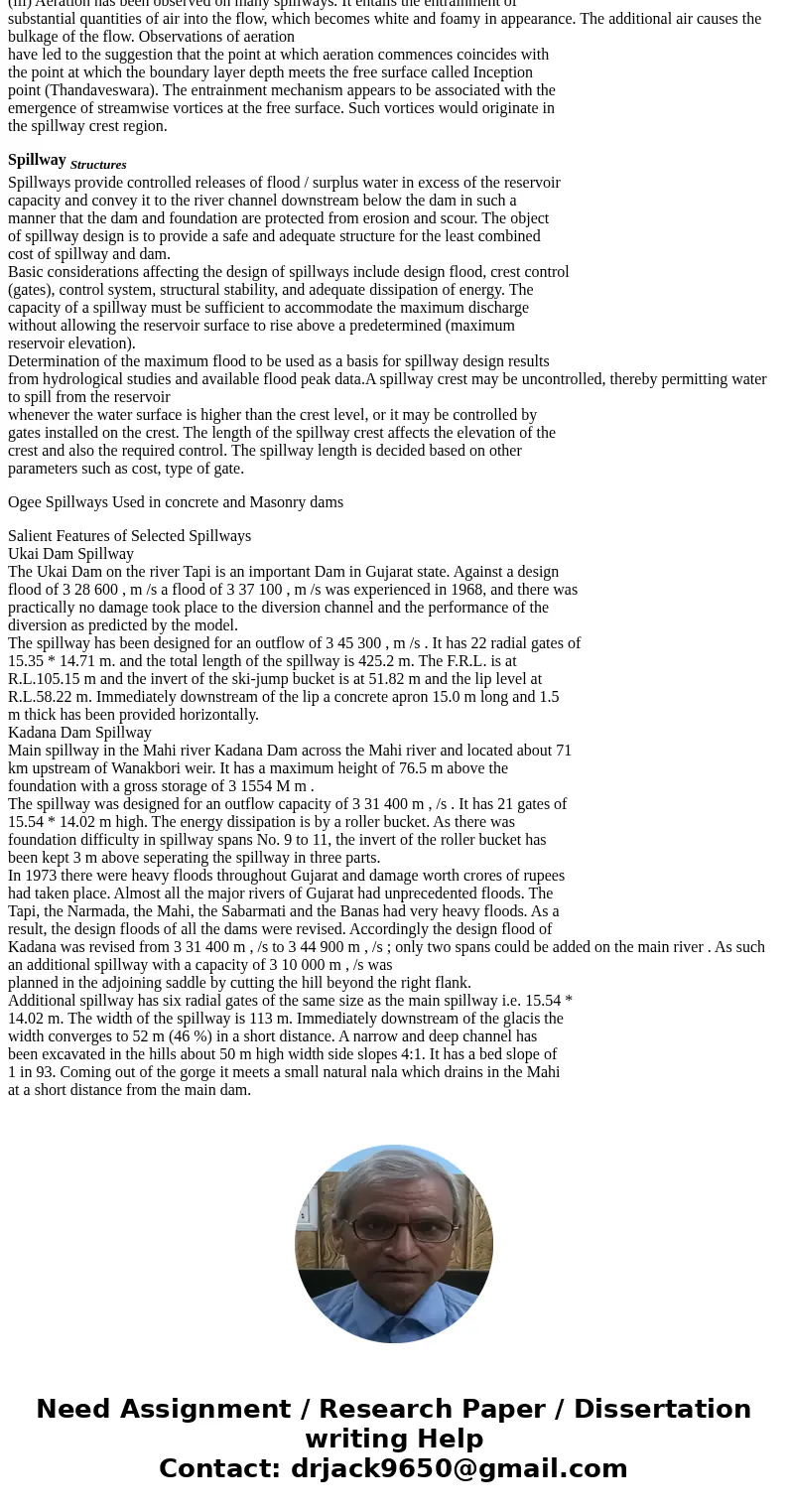Describe the design principles that are involved in the desi
Describe the design principles that are involved in the design of ogee spillway.
Solution
Spillway is a passage in a dam through which the design flood could be disposed off
safely to the downstream. The ogee-crested spillway, because of its superb hydraulic
characteristics, has been one of the most studied hydraulic structures. Its ability to pass
flows efficiently and safely, when properly designed, with relatively good flow measuring
capabilities, has enabled engineers to use it in a wide variety of situations. Although
much is understood about the general ogee shape and its flow characteristics, it is also
understood that a deviation from the standard design parameters such as a change in
upstream flow conditions, slightly modified crest shape, or construction variances can
change the flow properties. These small changes often require engineers to evaluate
the crest and determine whether or not the change or deviation will be detrimental to the
spillway\'s performance. Such is the case when an updated probable maximum flood
calculation requires a spillway to pass a larger flow than it was designed to handle.
In general, spillways comprise five distinct components namely: (i) an entrance channel,
(ii) a control structure, (iii) a discharge carrier, (iv) an energy dissipator, and (v) an outlet
channel. The entrance channel transfers water from the reservoir to the control
structure, which regulates the discharge from the reservoir. Water is then conveyed
from reservoir to the low-level energy dissipator on the riverbed by the discharge
conveyor. An energy dissipator is required to reduce the high velocity of the flow to a
nonscouring magnitude.
Most common types of spillway-control system used are roller, tainter, vertical-lift, and
drum gates. In view of the varying conditions, the choice of suitable gate is bound by the
cost , the head on the crest, the height of dam, and the hydraulic behaviour of the gate.
Piers are located on the spillway crest for the purpose of supporting the control gates,
the gate-operating mechanisms or a roadway. Their size and shape will vary
accordingly with their function. The piers should be streamlined both in the upstreamand the downstream sides to reduce contraction of the overflowing jet and to provide a
smooth water surface.
The element which introduces the energy-reducing action is generally known as \" stilling
basin.\" One of the most common methods out of several methods are dissipating the
flow at the toe of a spillway, is the hydraulic jump. Other types used in conjunction with
spillways are roller and trajectory buckets. Spillway outlets means the combination of
structures and equipment required for the safe operation and control of the water
released for different purposes for which the dam is planned. These structures may be
river outlets, penstocks, canal outlets. The size and number of river outlets satisfy the
discharge requirements at various stages of the reservoir . If the outlets are located in
the overflow portion, the conduits should be aligned downwards to minimise disturbance
to the flow over spillway. The discharge from an outlet, (gates, valves, or free-flow
conduits) has a relatively high velocity. Flow must expend the energy in order to prevent
scour of the bed and banks of the river channel. This may be accomplished by
constructing a stilling basin immediately downstream from the outlet.
The crest of the spillway is usually provided at F.R.L (Full Reservoir Level). However, in
order to control floods the gates could be provided at the top and the water level could
be increased upto maximum water level. The height between F.R.L and M.W.L is called
the \"Flood lift\". Reservoir level should not cross MWL. Following are different types of
spillways usually adopted in practice.
1. Overflow spillway.
2. Side channel spillway.
3. Shaft spillway.
4. Siphon spillway.
5. Chute.
6. Breaching section (emerging spillway).
Major dam will be usually provided with an overflow spillway with crest gates. However,
the type and location of spillway depends on the site conditions of topography.
Ogee Type Spillway Profile
This type of spillway is the most common type adopted in the field. It divides naturally
into three zones. Crest, spillway face and the toe. The concept evolves from replacing
the lower nappe of the flow over thin plate weir by solid boundary
The frictional resistance comes into play in case of solid boundary. Hence, the analysis
of flow profile is not aminable for analytical solutions. The high head spillways are
designed for proposed design head for the given discharge. However, the spillway will
also have to operate at lower heads and possibly higher heads as well. The former will
result in above atmospheric pressures on the crest and the lower discharge coefficient.
The latter behaves exactly in opposite manner namely sub atmospheric pressure,
higher discharge coeffiicient. From the experimental investigations by Rouse and Reid it
is found that the actual head may exceed the design head by atleast 50% with a 10%
increase in the coefficient of discharge subject to local pressures do not fall below the
cavitation level.However, in practice, this pressure reduction is not normally a serious problem unless H
> 1.5 Hd. Indeed, separation will not occur until H 3Hd. The acceptable range is 1.5
to 3.0 Hd.
If H < Hd - positive gauge pressure on crest.
If H > Hd - negative pressure develops on the surface.
Conditions in the flow down the spillway face may be quite complex, since
(i) the flow is accelerating rapidly, and may be \'expanding\' as it leaves a bay-pier
arrangement;
(ii) frictional shear promotes boundary layer growth.
(iii) the phenomenon of self - aeration of the flow may arise;
(iv) cavitation may occur (Velocity may reach 30 m/s for occurance of cavitation).
For these reasons, the usual equations for non-uniform flow developed for Gradually
Varied Flow cannot really be applied. If it is necessary to make estimates of flow
conditions on the spillway, then empirical data must be used.
(i) In a region of rapidly accelerating flow, the specific energy equation is usually
applied. It is possible to obtain very rough estimates of the variation of V and y down the
spillway on this basis, accuracy will be slightly improved if a head loss term is incorporated. Nevertheless, in the light of (ii) and (iii), below, conditions on the spillway
are far from those which underly the energy equations.
(ii) A boundary layer will form in the spillway flow, commencing at the leading edge of
the crest. The boundary layer thickness, , increases with the distance downstream of
the crest. The depth of the boundary layer, , will meet the free surface of the water
The flow of the crest is analogous to the flow round any fairly streamlined body. This
may imply flow seperation, eddy shedding, or both. Such condtions may be instrumental
in inducing cavitation at the spillway face. There have been a number of cases of
occurance of cavitation in major dams. For example Tungabhadra Dam.
(iii) Aeration has been observed on many spillways. It entails the entrainment of
substantial quantities of air into the flow, which becomes white and foamy in appearance. The additional air causes the bulkage of the flow. Observations of aeration
have led to the suggestion that the point at which aeration commences coincides with
the point at which the boundary layer depth meets the free surface called Inception
point (Thandaveswara). The entrainment mechanism appears to be associated with the
emergence of streamwise vortices at the free surface. Such vortices would originate in
the spillway crest region.
Spillway Structures
Spillways provide controlled releases of flood / surplus water in excess of the reservoir
capacity and convey it to the river channel downstream below the dam in such a
manner that the dam and foundation are protected from erosion and scour. The object
of spillway design is to provide a safe and adequate structure for the least combined
cost of spillway and dam.
Basic considerations affecting the design of spillways include design flood, crest control
(gates), control system, structural stability, and adequate dissipation of energy. The
capacity of a spillway must be sufficient to accommodate the maximum discharge
without allowing the reservoir surface to rise above a predetermined (maximum
reservoir elevation).
Determination of the maximum flood to be used as a basis for spillway design results
from hydrological studies and available flood peak data.A spillway crest may be uncontrolled, thereby permitting water to spill from the reservoir
whenever the water surface is higher than the crest level, or it may be controlled by
gates installed on the crest. The length of the spillway crest affects the elevation of the
crest and also the required control. The spillway length is decided based on other
parameters such as cost, type of gate.
Ogee Spillways Used in concrete and Masonry dams
Salient Features of Selected Spillways
Ukai Dam Spillway
The Ukai Dam on the river Tapi is an important Dam in Gujarat state. Against a design
flood of 3 28 600 , m /s a flood of 3 37 100 , m /s was experienced in 1968, and there was
practically no damage took place to the diversion channel and the performance of the
diversion as predicted by the model.
The spillway has been designed for an outflow of 3 45 300 , m /s . It has 22 radial gates of
15.35 * 14.71 m. and the total length of the spillway is 425.2 m. The F.R.L. is at
R.L.105.15 m and the invert of the ski-jump bucket is at 51.82 m and the lip level at
R.L.58.22 m. Immediately downstream of the lip a concrete apron 15.0 m long and 1.5
m thick has been provided horizontally.
Kadana Dam Spillway
Main spillway in the Mahi river Kadana Dam across the Mahi river and located about 71
km upstream of Wanakbori weir. It has a maximum height of 76.5 m above the
foundation with a gross storage of 3 1554 M m .
The spillway was designed for an outflow capacity of 3 31 400 m , /s . It has 21 gates of
15.54 * 14.02 m high. The energy dissipation is by a roller bucket. As there was
foundation difficulty in spillway spans No. 9 to 11, the invert of the roller bucket has
been kept 3 m above seperating the spillway in three parts.
In 1973 there were heavy floods throughout Gujarat and damage worth crores of rupees
had taken place. Almost all the major rivers of Gujarat had unprecedented floods. The
Tapi, the Narmada, the Mahi, the Sabarmati and the Banas had very heavy floods. As a
result, the design floods of all the dams were revised. Accordingly the design flood of
Kadana was revised from 3 31 400 m , /s to 3 44 900 m , /s ; only two spans could be added on the main river . As such an additional spillway with a capacity of 3 10 000 m , /s was
planned in the adjoining saddle by cutting the hill beyond the right flank.
Additional spillway has six radial gates of the same size as the main spillway i.e. 15.54 *
14.02 m. The width of the spillway is 113 m. Immediately downstream of the glacis the
width converges to 52 m (46 %) in a short distance. A narrow and deep channel has
been excavated in the hills about 50 m high width side slopes 4:1. It has a bed slope of
1 in 93. Coming out of the gorge it meets a small natural nala which drains in the Mahi
at a short distance from the main dam.



 Homework Sourse
Homework Sourse